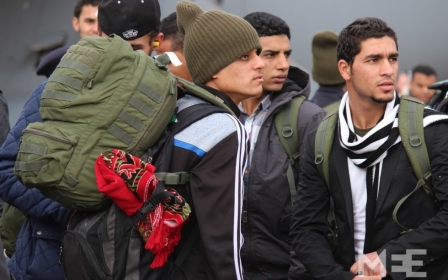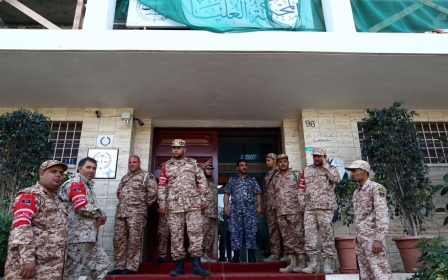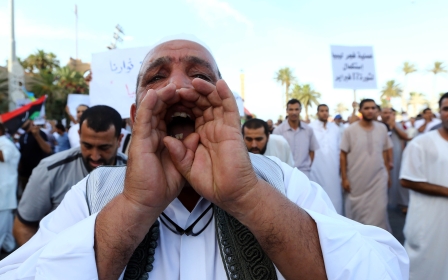The Massacre of Gharghour - one year later

One of the worst massacres in Libya after the toppling of Muammar Gaddafi - what has come to be known as the Massacre of Gharghour - took place one year ago, on 15 November, 2013.
Fighters from the port city of Misrata are reported to have used, among other weapons, anti-aircraft machine guns mounted on pickup trucks to fire at protesters flooding the roads leading to their base in Tripoli, formerly the home of one of Gaddafi's sons.
The incident started off innocently enough, with the Tripoli Local Council calling upon citizens to peacefully protest against the presence of the various militant groups that were fighting for control of the capital. Things quickly turned sour when militants from Misrata opened fire on a group of unarmed protesters - killing 47 and wounding at least 460.
On that fateful day, 39-year-old Salah al-Kikli opened his home to some of the wounded protesters, offering them shelter from the assault. At the time, Kikli expressed his fear that Misratan militias, which were a key part of the anti-Gaddafi Libya Shield force in Tripoli, might retaliate further if they re-took the capital.
Eight months later, after being expelled from the capital following the massacre, they did take over Tripoli and continue to be in control there today. Kikli has also now joined the fighting - side-by-side with the very militia he rose up against exactly a year ago.
His change in allegiance exemplifies the chaotic situation across the country, with friendships and treaties rarely lasting long.
Many of the armed groups battling one another for power in Libya today stood firmly together three years ago in more or less unified rebellion against Gaddafi and his dictatorial regime. Since then, new alliances have been formed. The memories of Gharghour, however, are proving to be reslient.
Witness to the Gharghour massacre
Despite having been planned as a day of peaceful protests against the presence of the militias that held sway in the capital, the resulting death and injury toll that Friday was devastating. Kikli could barely believe what he witnessed. Days afterwards, still in shock, he recalled: "They just opened fire. None of the protesters had weapons.”
Even when the first man died, the people around him didn't run. Instead, the thousands who had gathered continued their march forward, hoping to reason with the Misrata militia. The blood bath then started. Within hours, however, news of what happened had spread throughout the capital, as the names of those who had been killed found their way onto social media sites, honored as martyrs in the name of peace.
Misratan militants return to Tripoli
There is little doubt that the militia group that opened fire on the protesters came from Misrata, a city that rose to prominence in 2011 for its role in toppling Gaddafi. Misratans were glorified after 2011, and some feel that turned them into the dictators they once fought.
"They are just like Gaddafi," said the mother of Abdul Rahman, a 20-year-old protester who was killed in the massacre. She did not want her name published for safety reasons.
"We all supported Misrata [militias] through their struggle” against Gaddafi, she said.
After that blood-drenched day, an uncomfortable deal was reached. As the civilians in the city began arming themselves for protection, the Misrata tribe and city elders in Tripoli managed to reach an agreement for the safe passage of their militia out of the capital.
When the militia returned to Misrata, they were received as heroes, claiming that pro-Gaddafi forces had attacked them in a bid to reclaim power.
"The media lied about what happened. The protesters were armed," said Ahmed Al-Shwehdi, a Misrata fighter.
But relatives of those who died that day have refused to buy what they deem to be Misratan propaganda on this and the overthrow of Gaddafi. "My son fought in 2011 just as they did; they have no right to claim the revolution for themselves," Abdul Rahman's mother said.
The Misrata and Zintan alliance ends
When Tripoli was liberated from the grip of the Gaddafi regime in 2011, it was done with the help of Misratan rebels, as well as fighters from Zintan - a mountainous town southwest of the capital. At the time, both groups were greeted as heroes, but much has changed since then.
Misrata forces didn't return to Tripoli until May this year. By that time, political disagreements were running deep between them and Zintan's force.
The Zintan brigades had formed an alliance with rogue ex-general Khalifa Haftar, who launched a military operation to root out what he deemed to be Islamist-leaning militias, while the Misratan politicians had grown closer to Islamist-leaning politicians who opposed Haftar’s campaign and accused his camp of trying to bring back the old regime.
The divisions were now so deep that the Misratan militants decided that the once strong alliance had to come to an end and that the Zintan militias had to be rooted out. The renewed attacks for control of Tripoli lasted five weeks, with Misratan militants winning control of Tripoli by August.
During the first few weeks of fighting in July, the sense of betrayal was palpable. Inside one of the Zintan bases at Tripoli's international airport, Abdullah, a fighter from the mountains, told MEE at the time how bitter he was about Misratans turning their backs on their former allies.
"We helped secure the road for Misratans when the Gharghour massacre happened, so they could leave safely, and now look at how they are repaying us," he said.
By August, the charred remains of Libya's main airport belonged to the Misrata militias, and Kikli, back in Gharghour, was now worried.
His greatest fear was that Misrata's militiamen would go back to Gharghour and carry out revenge attacks against those who had tried to oust them. “When you get kidnapped by Zintans, you actually have a chance of being released,” he said. “But when you get kidnap by Misratan militants, you don’t have a chance."
So far, the Misratans have not returned to Gharghour, but what has surprised many is the shift toward the Misratan militias that has swept through the capital. Almost overnight, various smaller Tripoli militias joined in the fighting alongside Misratans in their eventually successful bid to dislodge the Zintan militia because they were allied politically through Libya's previous parliament, the General National Congress.
After the takeover of Tripoli, Zintan brigades were forced back to the mountains. In October, however, they decided to fight back, attacking the neighbouring town of Kikla, which was seen to have supported Misrata's forces during their Tripoli offensive.
It was this action that prompted Kikli’s switch of allegiance to the Misratans, for Kikla is his hometown and the Misratans were now fighting to defend it.
"Why? I mean there are only [a few] families in Kikla, now over 150 have been killed," he said.
Now Kikli openly praises Misrata, regardless of the deaths he witnessed at their hands only a year ago.
"In Gharghour things are quiet," Kikli said. "Misratans are OK, they are keeping Tripoli safe, and are fighting in my hometown - Kikla."
His allegiance is now so cemented that he has even joined in the fighting against the Zintans. "I was in Kikla for a week, then they closed the road," he said.
That does not mean all is forgiven and forgotten. Pictures of of the men and women who fell in the massacre a year ago are inscribed with prayers and hung on walls around the city. Meanwhile, the Misratan militia has tried to minimise its presence in Tripoli, and have let their allies man checkpoints in the city. Nor have they been back to Gharghour since 2013 - a decision Abu Baker al-Huta, a Misrata militiaman, said is deliberate.
"We don't want to cause any more problems," said Huta. "We try to keep all our forces away from Gharghour particularly."
The week leading up to the first anniversary of the massacre has been full of rumours that Tripoli would rise again in revenge and try to remove even the local militias who had sided with the Misratans. That would take remarkable courage against fighters who have not shied away from using armoured vehicles and machine guns to cement their rule.
New MEE newsletter: Jerusalem Dispatch
Sign up to get the latest insights and analysis on Israel-Palestine, alongside Turkey Unpacked and other MEE newsletters
Middle East Eye delivers independent and unrivalled coverage and analysis of the Middle East, North Africa and beyond. To learn more about republishing this content and the associated fees, please fill out this form. More about MEE can be found here.




